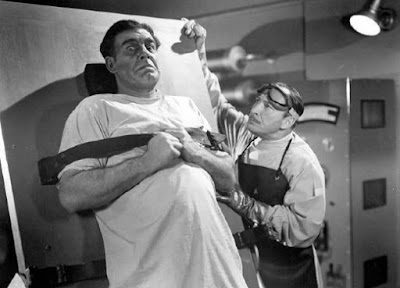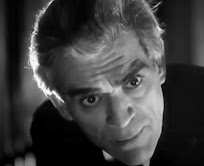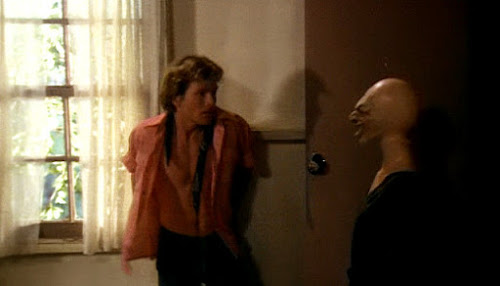We’re all waiting with bated breath as the world’s finest medical and scientific minds tirelessly work to come up with a vaccine for the coronavirus. When it happens, it will rank among humanity’s greatest medical achievements, right up there with Alexander Fleming’s discovery of penicillin and Jonas Salk’s polio vaccine.
The difference being that there will almost certainly not be an individual man or woman to point to as the latest hero of the 21st century (although no doubt some politicians will try to take credit). The complexity of the challenges and the resources needed to address them dictate that literal armies of brilliant minds work cooperatively and collectively, versus leaving it up to an eccentric lone wolf scientist burning the midnight oil in a secluded lab.
 |
| "It's okay doc, I'm feeling much better now... really I am!" |
Society is deeply ambivalent when it comes to brilliant lone wolves. On the one hand, we say we cherish individualism, ambition and initiative, and yet also seem to be smugly satisfied when some modern-day Icarus flies too high and comes crashing back down to earth.
One of the purest expressions of that love-hate relationship is the B-movie mad scientist. Whether they’re busy stitching together body parts and animating them with life, or concocting serums that can turn human beings into mind-controlled zombies, there’s nothing more fascinating or more deserving of punishment than the mad doctor dabbling in things better left alone.
It seems as if we value intelligence up to a certain point -- then, when we’re confronted with extraordinary genius, we’re deeply suspicious that such a gift is a license to disregard the value of “normal” human life. The movies help us work out the conundrum and restore order to the universe, at least on celluloid.
The mad doctors and scientists profiled below -- represented by some of the greatest names in classic horror -- are all inheritors of the Frankenstein tradition of lonely brilliance, a tendency to flout society’s norms, and hubris bordering on a God-complex. They up the ante by being willing to experiment on live people; no digging up subjects from the local graveyard for them.
While the mad theories, serum formulas and lab equipment vary from film to film, some plot elements pop up time and again:
- A brilliant but highly eccentric scientist is denounced and/or ostracized by his colleagues for his mad theories
- Seething with resentment, he locks himself away in an isolated lab, often in a large, remote mansion, working round the clock to prove himself to the world
- To anyone who will listen, the scientist compares himself to the great thinkers of history who were misunderstood in their day
- An innocent woman -- a daughter, niece, sister or colleague -- initially stands by the beleaguered scientist, holding out a slim hope of redemption for him
- The scientist is not just content to prove his discredited theory, but has to exact revenge on his disbelieving colleagues, even those who still respect him but don’t understand his mad obsession
- A young man, the boyfriend or fiance of the scientist’s daughter/niece/colleague (and often a newspaper reporter), becomes suspicious and starts nosing around
Please note: Thanks to the amazing Embed-O-Magic process, the full-length movies shared on this page are queued to a clip illustrating each mad doctor’s peculiar modus operandi. If you want to see how he gets his just deserts for flouting the laws of humanity and Nature, you’ll have to watch the full movie.
The Man Who Changed His Mind (aka The Man Who Lived Again, 1936)
The Man: Dr. Laurience (Boris Karloff)
The Plan: Dr. Laurience is a brain specialist whose eccentric theories got him kicked out of the research institute he was working at in Genoa. Now on his own, Laurience hires brilliant neurosurgeon Clare Wyatt (Anna Lee) to assist him with his experiments.
Laurience claims that he can “take the thought content from the mind of a living animal and store it as you would store electricity.” This content can then be transferred to another living being. To Clare’s amazement, he exchanges the minds of two chimpanzees, one gentle, the other fearful and aggressive.
Against his better judgment, the doctor takes up the offer of Lord Haslewood (Frank Cellier), a newspaper mogul and patron of the sciences, to relocate his equipment and experiments to Haslewood’s institute.
When Laurience presents his theories to a distinguished group of colleagues and is promptly ridiculed as a fraud, Haslewood fires the doctor and tells him that all his equipment and notes are the mogul’s property to do with as he sees fit. Laurience decides on the spot that he has the means to make the rich blowhard change his mind…
Man Made Monster (1941)
The Man: Dr. Paul Rigas (Lionel Atwill)
The Plan: When Dan McCormick (Lon Chaney, Jr.) becomes headline news as the sole survivor of a bus crash into power lines that electrocuted 5 other passengers, electro-biologists Dr. John Lawrence (Samuel S. Hinds) and Dr. Paul Rigas (Atwill) offer Dan room and board on Lawrence’s sprawling estate if he will agree to let the doctors examine him to find out why he is so immune to electricity (yes Virginia, there really is a branch of science called electro-biology).
Lawrence has a normal scientific curiosity with regard to Dan, but Rigas sees the potential for so much more: “I believe that electricity is life, that men can be motivated and controlled by electrical impulse supplied by the radioactivities of the electron. That eventually, a race of superior men can be developed, men whose only wants are… electricity!”
Lawrence’s niece June (Ann Nagel) and her fiance, newspaper reporter Mark Adams (Frank Albertson) are leery of Rigas. Adams sums up his impression of the doctor: “I bet he spent his childhood sticking pins in butterflies.”
While Lawrence is away at a scientific conference, Rigas pumps poor Dan with higher and higher doses of electricity in an effort to create an electro-man obedient to his will. When Lawrence returns and finds out what Rigas is doing, the madman must silence his colleague…
The Mad Monster (1942)
The Man: Dr. Cameron (George Zucco)
The Plan: Cameron’s mad theory -- that you can pass on the characteristics of animals to humans via blood transfusions -- has gotten him denounced by his colleagues and dismissed from his prestigious academic post.
When he succeeds in transforming his simple-minded gardener Petro (Glenn Strange) into a wolf-man, he imagines bringing together all his critics for an “I told you so” session:
“Just picture gentlemen, an army of wolfmen, fearless, raging, every man a snarling animal! My serum will make it possible to unloose millions of such animal men, men who are governed by one collective thought -- the animal lust to kill without regard to personal safety. Such an army will be invincible!”
But Cameron is not satisfied to just deliver tongue-lashings in his daydreams. He devises a diabolical plan to get his chief rival, Professor Blaine (Robert Strange), alone in a room with Petro, and have Blaine himself inject the handyman with the serum that turns him into a mindless killer…
The Ape Man (1943)
The Man: Dr. James Brewster (Bela Lugosi)
The Plan: Brewster, a famous gland expert but a sloppy scientist, uses himself as a guinea pig in his experiments and ends up as a hairy, hunched over human-ape hybrid. With the help of his colleague Dr. Randall (Henry Hall) and his sister Agatha (Minerva Urecal), he stages his own disappearance and hides out in the cellar of the family manor, desperately seeking a cure for his condition.
There is one hope, but there’s a catch. Human spinal fluid might help him return to his normal self, but it has to be harvested from living bodies, meaning instant death for the donor. When Randall draws the line at killing people, Brewster explodes in a fit of self-pitying rage: “It’s my life against somebody else’s -- I don’t want to live the rest of my life this way, and I WON’T!”
When a wisecracking reporter (Wallace Ford) and his photographer (Louise Currie) start snooping around the manor, the pressure is on. Brewster, with the aid of his pet gorilla, takes matters into his own hands to secure the precious spinal fluid…
The Unearthly (1957)
The Man: Dr. Charles Conway (John Carradine)
The Plan: Conway runs a private sanatorium in the middle of nowhere, where a number of people, including the beautiful but vulnerable Grace Thomas (Allison Hayes), are convalescing. They’ve been referred to the sanatorium by a duplicitous crony of Conway’s, Dr. Wright (Roy Gordon), to become unwitting guinea pigs in Conway’s secret experiments with glands (there are those glands again!) None have any family members who will notice if they go missing. Lobo (Tor Johnson), a hulking giant with the mind of a child (and a product of Conway’s experiments), is on hand to make sure the “patients” stay put.
In his research on human glands, Conway has found a way to “control the flow of vitamins” to them in order to create giants like Lobo, but he has also created a new artificial gland that in theory is the key to eternal youth: “I can prolong life for thousands of years, perhaps forever! Think of it, to be always, exactly as you are now. Suppose you could wake up every morning and see your face untouched by time!”
But to prove his theories, he needs a “completely sound physical specimen, mentally and physically perfect!” He thinks he has such a specimen in Mark Houston (Myron Healey), a fugitive criminal that Lobo found lurking around the property, and whom Conway has blackmailed into sticking around.
In the meantime, Conway continues to experiment on the other patients who have been lured to the house of horrors…












